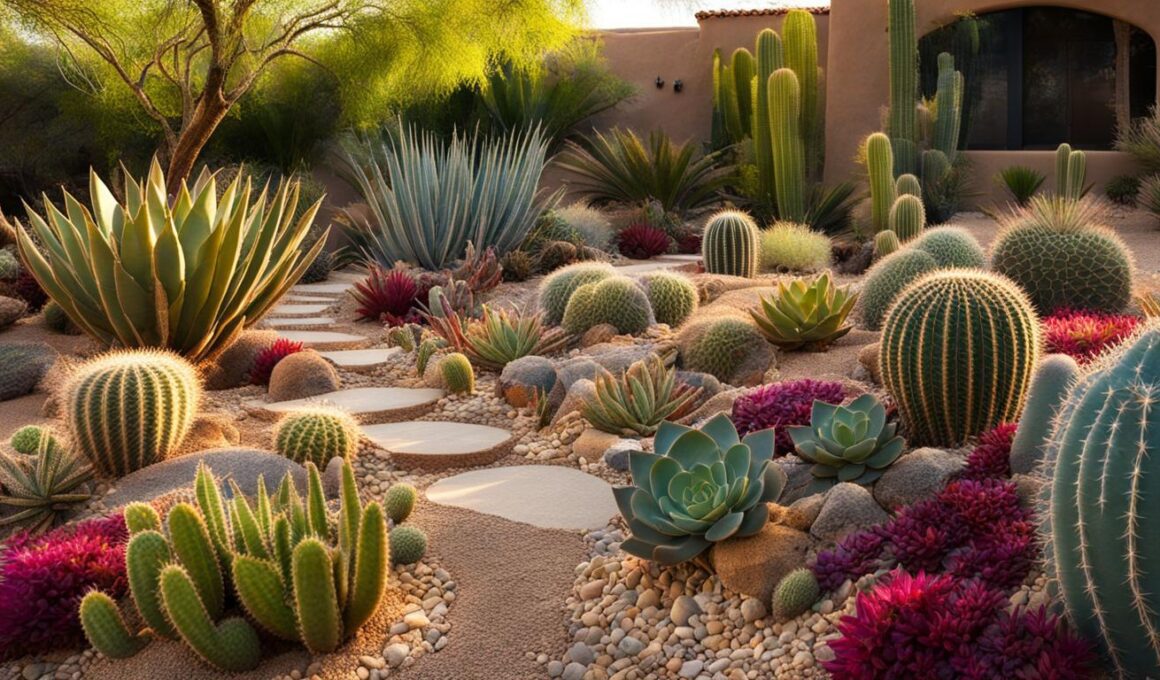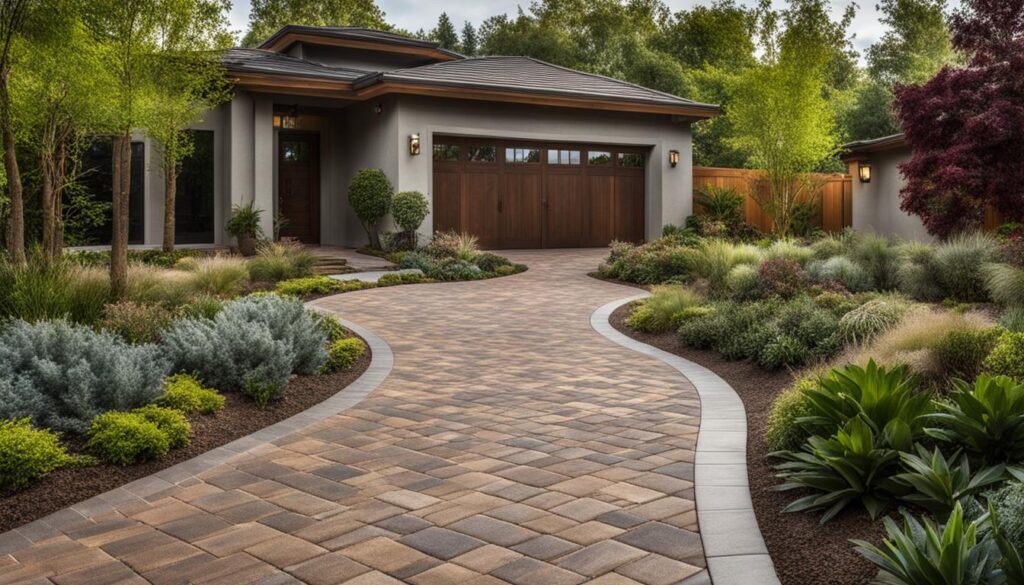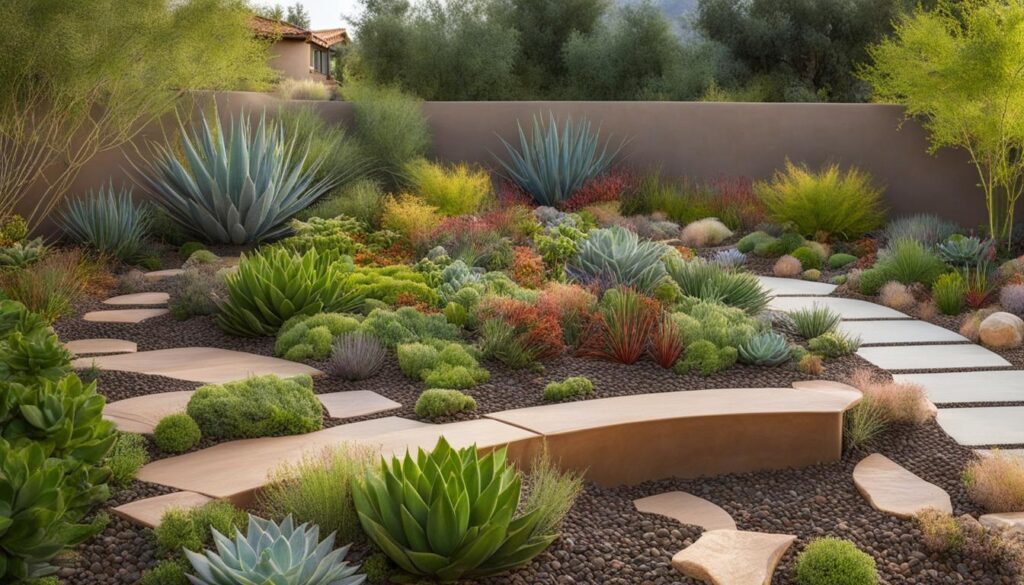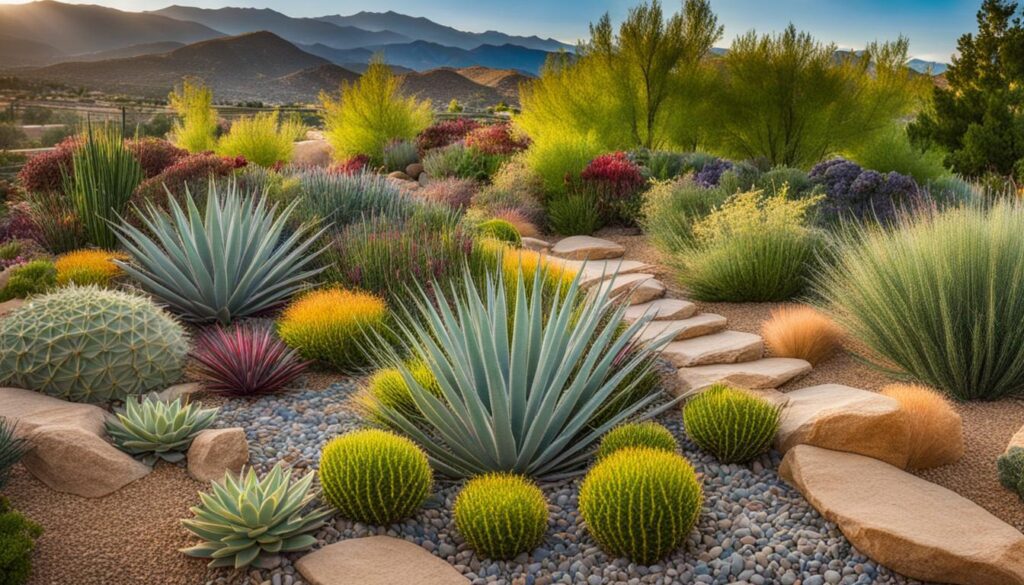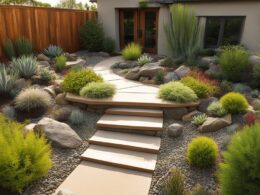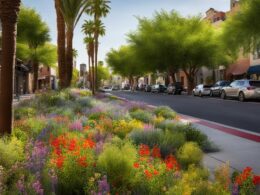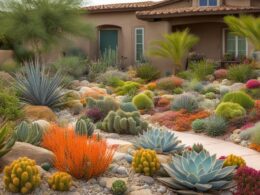Sustainable landscaping focuses on conserving resources, supporting the environment, and enhancing the beauty of outdoor spaces. Xeriscaping is a water-saving technique that uses drought-resistant plants and efficient irrigation systems. By incorporating xeriscaping principles into your landscape design, you can conserve water, reduce maintenance, and create a thriving space that respects the environment.
Key Takeaways
- Sustainable landscaping aims to conserve resources and enhance outdoor spaces.
- Xeriscaping is a water-saving technique that uses drought-resistant plants and efficient irrigation systems.
- By incorporating xeriscaping principles, you can conserve water and reduce maintenance.
- Sustainable landscaping contributes to the overall beauty of the landscape.
- Xeriscaping can be implemented by choosing drought-resistant plants and efficient irrigation systems.
The Benefits of Sustainable Landscaping
Sustainable landscaping offers numerous benefits for both the environment and homeowners. By implementing sustainable practices, such as xeriscaping, you can enjoy the following advantages:
- Water conservation: Sustainable landscaping reduces water consumption by incorporating drought-resistant plants and efficient irrigation systems. This helps conserve water resources and ensures compliance with municipal watering guidelines.
- Cost savings: With water being a precious resource, sustainable landscaping can lead to significant cost savings on water bills. By using less water for irrigation, you can reduce your monthly expenses.
- Low maintenance: Sustainable landscapes are designed to be drought-tolerant and require less maintenance. By choosing plants that can thrive in your region’s climate, you can minimize the need for constant watering, fertilization, and pest control.
“Sustainable landscaping reduces water consumption, saves money, and requires less maintenance.” – Stephen Johnson, Landscape Architect
Sustainable landscapes also contribute to the overall beauty and functionality of outdoor spaces. By incorporating diverse plant options, you can create an aesthetically pleasing environment that enhances the curb appeal of your property.
Next, we will delve deeper into xeriscaping, a popular water-saving technique that plays a crucial role in sustainable landscaping.
Xeriscaping: A Water-Saving Technique
Xeriscaping is a water-saving technique that has gained popularity in recent years. By incorporating drought-resistant plants, efficient irrigation systems, and thoughtful design, xeriscaping allows you to create a beautiful and sustainable landscape while conserving water resources.
One of the key aspects of xeriscaping is the use of drought-resistant plants. These plants are specifically chosen for their ability to thrive in arid conditions, requiring minimal water once established. By selecting native plants and those adapted to your local climate, you can ensure that your landscape remains vibrant and resilient even during dry periods.
In addition to the selection of drought-resistant plants, xeriscaping involves the implementation of efficient irrigation systems. Drip irrigation is a common method used in xeriscaping, delivering water directly to the roots of plants in a slow and controlled manner. This minimizes water wastage through evaporation and runoff, ensuring that every drop is utilized effectively.
Furthermore, xeriscaping incorporates elements such as mulch, stones, and gravel to retain moisture in the soil. Mulch acts as a protective layer, reducing weed growth and preventing water evaporation from the soil surface. Stones and gravel can be strategically placed to create functional and visually appealing features that require little to no water.
Incorporating Xeriscaping into Your Landscape
When it comes to sustainable landscaping, incorporating xeriscaping principles can make a significant impact. By choosing drought-resistant plants and implementing efficient irrigation systems, you can create a beautiful and water-wise landscape. Here are some key steps to help you incorporate xeriscaping into your outdoor space:
- Choose drought-resistant plants: Opt for native or adapted plants that are well-suited to your region’s climate. These plants have evolved to thrive in specific conditions and require less water to survive.
- Consider plant grouping and placement: Group plants with similar water needs together to minimize water wastage. Place plants strategically, considering factors like sun exposure, wind patterns, and soil moisture levels.
- Install efficient irrigation systems: Drip irrigation is an excellent choice for xeriscaping as it delivers water directly to the roots, minimizing evaporation and water loss. Install a timer to ensure precise watering schedules and conserve water.
Soil preparation and mulching:
“Proper soil preparation is crucial for xeriscaping success. Amend the soil with organic matter to improve its water-holding capacity and ensure proper drainage. Apply a layer of mulch around plants to help retain moisture, suppress weed growth, and regulate soil temperatures.”
By following these steps, you can create a sustainable landscape that not only conserves water but also requires minimal maintenance. Incorporating xeriscaping into your outdoor space allows you to enjoy a beautiful and thriving landscape while reducing your ecological footprint.
Efficient irrigation:
Xeriscaping is an ideal opportunity to implement efficient irrigation systems, such as drip irrigation. This method delivers water directly to the roots of plants, reducing water wastage and evaporation. Drip irrigation can be easily installed and is highly efficient, ensuring that plants receive the necessary water without excess runoff.
Other Sustainable Landscaping Techniques
In addition to xeriscaping, there are several other sustainable landscaping techniques that you can consider incorporating into your outdoor space. These techniques not only contribute to water conservation but also enhance the beauty and functionality of your landscape.
Native Plants
One effective way to create a sustainable landscape is by planting native plants. Native plants are adapted to the local climate and require less water, fertilizer, and pesticides compared to exotic species. By incorporating native plants into your landscape design, you can reduce water consumption and maintenance while supporting the local ecosystem.
Rain Gardens
Rain gardens are designed to collect and absorb rainwater, reducing runoff and preventing erosion. They are typically planted with native plants that can tolerate both wet and dry conditions. By directing excess water to rain gardens, you can create visually appealing and environmentally beneficial features within your landscape.
Permeable Pavers
Permeable pavers are an excellent option for driveways, walkways, and patio areas. These pavers allow rainwater to percolate through the surface, reducing runoff and promoting water infiltration into the soil. By choosing permeable pavers, you can minimize stormwater runoff and contribute to water conservation in your landscape.
By incorporating these sustainable landscaping techniques – native plants, rain gardens, and permeable pavers – into your landscape design, you can create a beautiful and eco-friendly outdoor space. These techniques not only conserve water but also support local biodiversity and reduce the environmental impact of your landscape.
Incorporating Sustainable Landscaping with K-Rain Products
In your journey towards sustainable landscape design, incorporating K-Rain products is an excellent way to promote water conservation and enhance the efficiency of your irrigation systems. K-Rain offers a range of sprinkler systems and products that are designed to support sustainable landscaping practices.
One of the key products offered by K-Rain is their drip irrigation kits. Drip irrigation is a highly efficient watering method that delivers water directly to the roots of plants, minimizing water waste by reducing evaporation and runoff. These kits are easy to install and provide precise control over water distribution, ensuring that your xeriscaped plants receive the right amount of water they need to thrive.
“With K-Rain’s drip irrigation kits, you can ensure that every drop of water is utilized efficiently.”
K-Rain also offers tree bubblers, which are specially designed to provide slow, deep watering for trees and shrubs. This helps promote root growth and reduces water runoff. By incorporating K-Rain’s tree bubblers into your sustainable landscape, you can create an environment that supports the growth and longevity of your plants while conserving water.
Whether you are a DIY enthusiast or prefer professional assistance, K-Rain provides options to suit your needs. Their products and systems are designed to be user-friendly and adaptable to different landscapes, making it easier for you to create a sustainable outdoor space that aligns with your vision and values.
The Importance of Xeriscaping in Colorado’s Front Range
Xeriscaping plays a crucial role in Colorado’s Front Range, where water conservation is of utmost importance. This region is prone to droughts and limited water resources, making it essential for homeowners to adopt sustainable landscaping practices. By implementing xeriscaping techniques, you can create a beautiful and thriving landscape that not only reduces water consumption but also withstands the challenging climate conditions.
Colorado’s Front Range faces water scarcity issues, and traditional landscaping practices can contribute to excessive water usage. Xeriscaping, on the other hand, focuses on using drought-tolerant plants, efficient irrigation systems, and mulch to minimize water wastage. By choosing native and low-water plants, you can create a landscape that thrives in the arid conditions of this region.
Furthermore, xeriscaping in Colorado’s Front Range promotes drought-tolerant landscaping, which is crucial for maintaining the ecological balance. By conserving water and reducing the need for high-maintenance landscapes, xeriscaping helps preserve the local environment and minimizes the strain on natural resources. It also provides an opportunity to create a unique and visually appealing landscape that complements the natural beauty of Colorado.
Key Benefits of Xeriscaping in Colorado’s Front Range:
- Efficient water utilization in a water-scarce region.
- Reduction in water bills and overall water consumption.
- Minimal maintenance requirements for a sustainable landscape.
- Preservation of the local environment and native plant species.
- Enhancement of the overall aesthetic appeal of the landscape.
By embracing xeriscaping in Colorado’s Front Range, you contribute to the larger goal of water conservation and sustainability. It is a responsible choice that not only benefits you as a homeowner but also helps preserve the natural beauty of the region for future generations to enjoy.
How Can I Implement Sustainable Landscape Design with Xeriscaping Techniques?
Implementing sustainable landscape design with the best xeriscape landscaping practices is an effective way to conserve water and create an environmentally friendly outdoor space. By using drought-resistant plants, efficient irrigation systems, and natural mulch, xeriscaping techniques can reduce water usage and maintenance while still achieving an attractive and thriving landscape.
Conclusion
In conclusion, sustainable landscape design with xeriscaping is a smart choice for creating an environmentally-friendly outdoor space. By incorporating xeriscaping principles, such as using drought-resistant plants and efficient irrigation systems, you can conserve water, reduce maintenance, and support the local ecosystem.
Not only does sustainable landscape design benefit the environment, but it also offers practical advantages. You can enjoy cost savings on water bills, as well as a landscape that remains vibrant and beautiful even in dry conditions.
Consider incorporating other sustainable landscaping techniques, such as planting native plants, creating rain gardens, and using permeable pavers, to further enhance the sustainability of your landscape design. And don’t forget to explore the range of K-Rain products, including drip irrigation kits and tree bubblers, that can help you achieve efficient water conservation.
Take the first step towards a greener future by embracing sustainable landscape design with xeriscaping. By doing so, you’ll not only create a visually stunning outdoor space, but also contribute to water conservation efforts and support the preservation of our natural resources.





